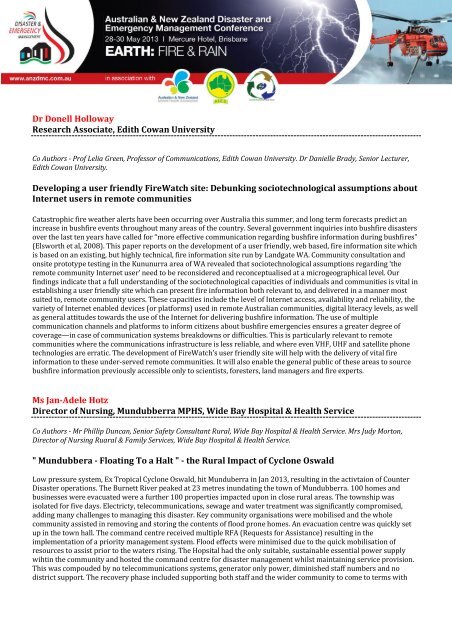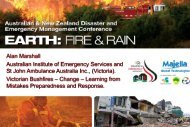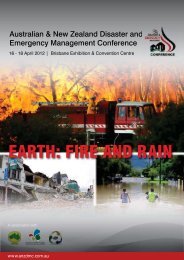Book of Abstracts 2013 - Australian and New Zealand Disaster ...
Book of Abstracts 2013 - Australian and New Zealand Disaster ...
Book of Abstracts 2013 - Australian and New Zealand Disaster ...
Create successful ePaper yourself
Turn your PDF publications into a flip-book with our unique Google optimized e-Paper software.
Dr Donell Holloway<br />
Research Associate, Edith Cowan University<br />
Co Authors - Pr<strong>of</strong> Lelia Green, Pr<strong>of</strong>essor <strong>of</strong> Communications, Edith Cowan University. Dr Danielle Brady, Senior Lecturer,<br />
Edith Cowan University.<br />
Developing a user friendly FireWatch site: Debunking sociotechnological assumptions about<br />
Internet users in remote communities<br />
Catastrophic fire weather alerts have been occurring over Australia this summer, <strong>and</strong> long term forecasts predict an<br />
increase in bushfire events throughout many areas <strong>of</strong> the country. Several government inquiries into bushfire disasters<br />
over the last ten years have called for “more effective communication regarding bushfire information during bushfires”<br />
(Elsworth et al, 2008). This paper reports on the development <strong>of</strong> a user friendly, web based, fire information site which<br />
is based on an existing, but highly technical, fire information site run by L<strong>and</strong>gate WA. Community consultation <strong>and</strong><br />
onsite prototype testing in the Kununurra area <strong>of</strong> WA revealed that sociotechnological assumptions regarding ‘the<br />
remote community Internet user’ need to be reconsidered <strong>and</strong> reconceptualised at a microgeographical level. Our<br />
findings indicate that a full underst<strong>and</strong>ing <strong>of</strong> the sociotechnological capacities <strong>of</strong> individuals <strong>and</strong> communities is vital in<br />
establishing a user friendly site which can present fire information both relevant to, <strong>and</strong> delivered in a manner most<br />
suited to, remote community users. These capacities include the level <strong>of</strong> Internet access, availability <strong>and</strong> reliability, the<br />
variety <strong>of</strong> Internet enabled devices (or platforms) used in remote <strong>Australian</strong> communities, digital literacy levels, as well<br />
as general attitudes towards the use <strong>of</strong> the Internet for delivering bushfire information. The use <strong>of</strong> multiple<br />
communication channels <strong>and</strong> platforms to inform citizens about bushfire emergencies ensures a greater degree <strong>of</strong><br />
coverage—in case <strong>of</strong> communication systems breakdowns or difficulties. This is particularly relevant to remote<br />
communities where the communications infrastructure is less reliable, <strong>and</strong> where even VHF, UHF <strong>and</strong> satellite phone<br />
technologies are erratic. The development <strong>of</strong> FireWatch’s user friendly site will help with the delivery <strong>of</strong> vital fire<br />
information to these under-served remote communities. It will also enable the general public <strong>of</strong> these areas to source<br />
bushfire information previously accessible only to scientists, foresters, l<strong>and</strong> managers <strong>and</strong> fire experts.<br />
Ms Jan-Adele Hotz<br />
Director <strong>of</strong> Nursing, Mundubberra MPHS, Wide Bay Hospital & Health Service<br />
Co Authors - Mr Phillip Duncan, Senior Safety Consultant Rural, Wide Bay Hospital & Health Service. Mrs Judy Morton,<br />
Director <strong>of</strong> Nursing Ruaral & Family Services, Wide Bay Hospital & Health Service.<br />
" Mundubbera - Floating To a Halt " - the Rural Impact <strong>of</strong> Cyclone Oswald<br />
Low pressure system, Ex Tropical Cyclone Oswald, hit Munduberra in Jan <strong>2013</strong>, resulting in the activtaion <strong>of</strong> Counter<br />
<strong>Disaster</strong> operations. The Burnett River peaked at 23 metres inundating the town <strong>of</strong> Mundubberra. 100 homes <strong>and</strong><br />
businesses were evacuated were a further 100 properties impacted upon in close rural areas. The township was<br />
isolated for five days. Electricty, telecommunications, sewage <strong>and</strong> water treatment was significantly compromised,<br />
adding many challenges to managing this disaster. Key community organisations were mobilised <strong>and</strong> the whole<br />
community assisted in removing <strong>and</strong> storing the contents <strong>of</strong> flood prone homes. An evacuation centre was quickly set<br />
up in the town hall. The comm<strong>and</strong> centre received multiple RFA (Requests for Assistance) resulting in the<br />
implementation <strong>of</strong> a priority management system. Flood effects were minimised due to the quick mobilisation <strong>of</strong><br />
resources to assist prior to the waters rising. The Hopsital had the only suitable, sustainable essential power supply<br />
wihtin the community <strong>and</strong> hosted the comm<strong>and</strong> centre for disaster management whilst maintaining service provision.<br />
This was compouded by no telecommunications systems, generator only power, diminished staff numbers <strong>and</strong> no<br />
district support. The recovery phase included supporting both staff <strong>and</strong> the wider community to come to terms with






